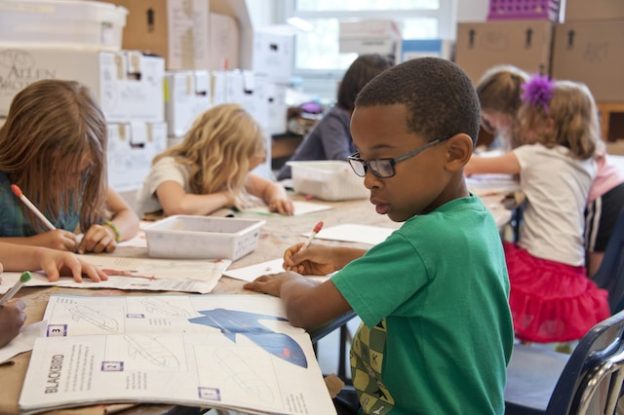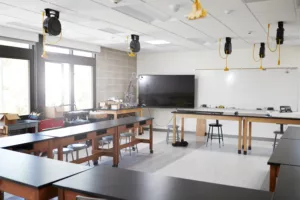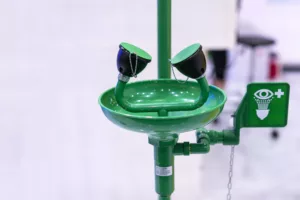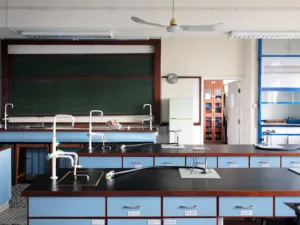This document is part of a continuum of school science learning beginning with the NSTA position statement, Early Childhood Science Education (NSTA 2014), and continuing with the NSTA position statement, Science Education for Middle Level Students(NSTA 2016a). More information can be found on the NSTA website.
—Adopted by the NSTA Board of Directors, October 2018
References
- Cervetti, G. N., J. Barber, R. Dorph, P. D. Pearson, and P. G. Goldschmidt. 2012. The impact of an integrated approach to science and literacy in elementary school classrooms. Journal of Research in Science Teaching 49(5): 631–658.
- DeVries, R., and B. Zan. 2012. Moral classrooms, moral children: Creating a constructivist atmosphere in early education. New York, NY: Teachers College Press.
- Horizon Research, Inc. 2013. 2012 National survey of science and mathematics education: Highlights Report. Chapel Hill, NC.
- Katz, L. G. 2010. STEM in the early years. Collected Papers from the SEED Conference, Fall 2010. Retrieved from 5/1/17.
- Lederman, N. 2014. Guest Editorial: Nature of Science and Its Fundamental Importance to the Vision of the Next Generation Science Standards. Science and Children 52 (1): 8–10.
- McClure, E. R., L. Guernsey, D. H. Clements, S. N. Bales, J. Nichols, N. Kendall-Taylor, and M. H. Levine. 2017. STEM starts early: Grounding science, technology, engineering, and math education in early childhood. New York: The Joan Ganz Cooney Center at Sesame Workshop.
- Metz, K. E. 2011. Disentangling robust developmental constraints from the instructionally mutable: Young children’s epistemic reasoning about a study of their own design. The Journal of the Learning Sciences 20(1): 50–110.
- Moulding, B., R. Bybee, and N. Paulson. 2015. A vision and plan for science teaching and learning. Essential Teaching and Learning Publications.
- National Research Council (NRC). 2007. Taking science to school: Learning and teaching science in grades K–8. Washington, DC: National Academies Press.
- National Research Council (NRC). 2008. Ready, set, SCIENCE!: Putting research to work in K–8 science classrooms. Washington, DC: National Academies Press.
- National Research Council (NRC). 2012. A framework for K–12 science education: Practices, crosscutting concepts, and core ideas. Washington, DC: National Academies Press.
- National Science Teachers Association (NSTA). 2009. Parent Involvement in Science Learning. Arlington, VA: NSTA.
- National Science Teachers Association (NSTA). 2012. Learning Science in Informal Environments. Arlington, VA: NSTA.
- National Science Teachers Association (NSTA). 2014. Early Childhood Science Education. Arlington, VA: NSTA.
- National Science Teachers Association (NSTA). 2015. Safety and School Science Instruction. Arlington, VA: NSTA.
- National Science Teachers Association (NSTA). 2016a. Science Education for Middle Level Students. Arlington, VA: NSTA.
- National Science Teachers Association (NSTA). 2016b. The Next Generation Science Standards. Arlington, VA: NSTA.
- National Science Teachers Association (NSTA). 2018. Transitioning from Scientific Inquiry to Three-Dimensional Teaching and Learning. Arlington, VA: NSTA.
- Satchwell, R. E., and F. L. Loepp. 2002. Designing and Implementing an Integrated Mathematics, Science, and Technology Curriculum for the Middle School. Journal of Industrial Teacher Education 39(3).
Additional Resources
- National Research Council (NRC). 2014. Developing assessments for the next generation science standards. Washington, DC: National Academies Press.
- Stohr-Hunt, P. M. 1996. An analysis of frequency of hands-on experience and science achievement. Journal of Research in Science Teaching 33 (1): 101–109.
Overview
Science learning begins long before children enter formal education. Their innate curiosity about the world and how it works prompts them to independently develop rudimentary forms of scientific investigations and design activities to find answers to their questions and solutions to their problems (NRC 2007). Effective elementary education recognizes and capitalizes on children’s intrinsic interest in science and engineering, builds upon the initial concepts and strategies children have acquired, and provides an educational environment that allows those concepts and strategies to expand and deepen.
In many schools and districts, however, elementary science instruction often takes a back seat to math and reading and receives little time in the school day. Many elementary educators do not receive an adequate amount of professional learning to gain the confidence needed to teach science (Horizon Research 2013; McClure et al. 2017).
The release of A Framework for K–12 Science Education (Framework; NRC 2012) provides a new vision for science teaching and learning, and recommends important conceptual shifts in science instruction. NSTA supports this new vision—and its application in the Next Generation Science Standards (NGSS)—and recommends all educators make the transition to three-dimensional teaching and learning (NSTA 2016b, 2018).
The NSTA has identified the following key principles to guide effective science learning in the elementary grades:
- The elementary educational environment plays a key role in student learning. Students thrive with teachers who consider all aspects of space (physical, socio-emotional, gallery, and intellectual) for creative and in-depth learning (DeVries and Zan 2012). Such an environment provides children with opportunities to engage in the practices of science, engineering, and mathematics daily through real-world applications during the course of exploring topics of interest and relevance.
- Elementary students have the capacity to engage in scientific and engineering practices as they develop conceptual understandings over time. High-quality science instruction moves students from curiosity to interest to reasoning (Moulding, Bybee, and Paulson 2015). The progression of learning occurs with each science and engineering experience and is magnified by frequency and intentionality. As noted in the NSTA position statement, Early Childhood Science Education, children have the capacity to engage in scientific practices and develop understanding at a conceptual level (NSTA 2014), and early in their science education, they need opportunities to observe phenomena, engage in problem solving, and provide explanations of their thinking (Katz 2010). Over time and through multiple and varied experiences, children develop skills in scientific discourse. They construct more detailed models and explanations, and listen to and critique the explanations of others. Children enter the realm of scientists as they plan and carry out investigations, solve problems, create models, analyze and interpret data, construct explanations, and design solutions. These opportunities allow them to deepen their understandings of fundamental concepts over time.
- Elementary students can and should engage in science within the broader community of science. There are numerous possibilities to support students’ science engagement in the community and this can occur both in and out of the classroom. Tapping into the broader scientific community allows children to become active participants within diverse cultures of practicing scientists and engineers. Out-of-school settings can provide additional learning experiences for students within the context of their daily lives, as outlined in the NSTA position statement, Learning Science in Informal Environments (NSTA 2012).
- There must be adequate time in every school day to engage elementary students in high-quality science instruction that actively involves them in the processes of science. NSTA does not find a research basis for recommending a specific number of minutes for teaching core content, including science. However, most states, districts, and schools currently prescribe a set number of minutes—either by day, week, or year. As a result of this practice, science receives far less instruction time than other core subjects (Horizon Research 2013). NSTA recommends that science be given equal priority as other core subjects, so schools should strive for at least 60 minutes of science instruction a day, including significant science investigations.
Declarations
NSTA provides the following recommendations to support high-quality science education in elementary classrooms.
To support high-quality elementary science learning, NSTA recommends that science educators
- use science and engineering practices to actively engage students in science learning, embed the learning of science concepts within scientific and engineering practices and through crosscutting concepts, and use real-world application of interest and relevance to engage students in three-dimensional instruction (NSTA 2018);
- build on students’ embodied knowledge and understanding of the world and help them confront their misconceptions (NRC 2008, p. 38);
- give students time and space to structure their own investigations in a familiar domain as a way to encourage their investment in learning and engagement in reasoning (Metz 2011);
- consider development and learning, individuality, and social and cultural contexts as children mature, while also introducing experiences outside of children’s own life experiences as they move towards more abstract concepts;
- provide authentic formative and summative assessments to guide and assist development of conceptual understandings;
- practice science as a social endeavor in which knowledge is based on empirical evidence;
- explicitly integrate discussions and a variety of lessons to support an understanding of the Nature of Science (Lederman 2014);
- involve students in scientific discourse to help them make evidence-based conclusions and decisions, and communicate those conclusions and decisions effectively through speaking and writing;
- immerse students in a variety of scientific text and literature genres to develop an understanding of the different purposes for which each is used;
- embed authentic mathematical applications within scientific and technological investigations and engineering designs providing deeper understanding of content and processes in science, technology, engineering, and mathematics (STEM);
- promote science learning for all children regardless of language, gender, race, ethnicity, age, skill, cognitive and physical abilities, or economic status;
- help students understand the difference between scientific data, beliefs, and opinions;
- work to integrate all the disciplines in the elementary curriculum with science;
- adhere to professional practices and legal safety standards outlined in NSTA’s position statement Safety and School Science Instruction (NSTA 2015) and be proactive in ensuring that school and school district leaders know and are adhering to these safety expectations; and
- encourage and engage families to support children’s interest and investigation in science and other STEM activities through communication including sharing of community resources.
To support high-quality elementary science learning, NSTA recommends that administrators and/or curriculum specialists
- continually develop knowledge of child development and learning progressions within science, engineering, and mathematics to design appropriate and engaging science experiences for elementary children;
- ensure teachers have adequate time to engage students every day in high-quality science instruction that actively involves students in the processes of science;
- provide research-based, developmentally appropriate, high-quality science resources and materials for teachers with adequate time to engage in the same hands-on, engaging learning environments and practices they provide to children (McClure et al. 2017);
- provide ongoing research-based opportunities within professional learning communities for teachers that meaningfully integrate the processes of reading, writing, and mathematics within scientific investigation and engineering design;
- support community and school partnerships that provide real-world science education experiences for students and teachers, such as offering regular opportunities for teachers to collaborate with and learn from experienced science and engineering professionals in a variety of settings; and
- ensure that student learning opportunities are implemented through research-based best practices that integrate reading, writing, and mathematics with science instruction in ways shown to measurably improve skills and knowledge (Cervetti et al. 2012; Satchwell and Loepp 2002).
To support high-quality elementary science learning, NSTA recommends that policy makers
- align district and state policies to support the recommendations of the Framework, and the NGSS if adopted, including teacher professional learning;
- work with all levels of government (federal, state, and local) to apply existing and new funding resources to improve general science teaching;
- serve as advocates for policies that provide equitable science education for all; and
- support community and school partnerships that provide authentic science education experiences for students and teachers.
To support high-quality elementary science learning, NSTA recommends that professional development for classroom teachers and preparation for future elementary teachers
- counter pre-existing anxiety and attitudes about science through opportunities to experience the same hands-on, engaging learning environments and research-based best practices that support deeper, conceptual understandings in children;
- involve participants in experiential activities to develop an understanding of the learning progressions within both the content and processes of science, including the ability to diagnose and address common misconceptions, and to provide appropriate differentiation strategies;
- require specific coursework in the areas of physical science, life science, and Earth science designed to model the three-dimensional integration of the practices of science and engineering while reinforcing the nature of science in a developmentally appropriate context;
- include regular opportunities to develop, use, and reflect upon authentic formative and summative assessment to uncover student thinking, detect possible misconceptions, and modify learning experiences accordingly, both as an individual and within a professional learning community;
- engage in meaningful discussion of methods for embedding reading, writing, and mathematics within the context of active science learning; and
- advocate for and schedule regular meetings with experienced elementary science mentors within and across grade levels to analyze assessment data, reflect on the lesson design, and develop confidence in providing instruction for children of all ages.
To support high-quality elementary science learning, NSTA recommends families support their children’s science learning as outlined in the NSTA position statement, Parent Involvement in Science Education (NSTA 2009). This broadly includes
- nurturing the wonder, enthusiasm, and curiosity in children of all ages by creating a positive and safe environment at home for exploration and discovery;
- being actively engaged in children’s schooling; and
- encouraging children to consider and pursue a science- or technology-related career and obtaining the necessary knowledge and skills that will allow them access to and success in such a career.















